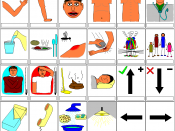"Nonverbal communication is a silent infiltrator, having broad influence over our social environment. It provides us with a mode for conveying messages without the use of verbal language." (Dunn 1999) It is not what you say; it is the way you are sitting. Have you ever listened to someone and heard what he or she said, but felt puzzled for some unknown reason? If so, you probably were receiving nonverbal communication that was not consistent with the verbal communication. Personal behavior is critical in a person's ability to communicate effectively. Both verbal and nonverbal communication is related and very important in our interactions with others. There are many types of non-verbal communication that can be used to contradict verbal messages, such as facial expressions, eye contact, hand gestures and personal appearance. Observing and identifying behavior in verbal and nonverbal interactions of others can help increase a person's ability to communicate more effectively.
Non-verbal communication is used so often that we actually forget that we are using it. It is defined as the basic above definition but unconsciously our minds are attuned to the posture and spatial distance between two or more people. It provides us with a means for conveying messages without the use of verbal language and also plays a role in the perception of the actual message we are trying to convey.
We do not realize how much we rely on non-verbal communication; the reason for this is due to the fact that most non-verbal communication transpires on a level that is below our conscious awareness. While many aspects of nonverbal communication are culturally specific, some, e.g. facial expressions and gestures, appear to have near universal levels of recognition. It is suggested that many more feelings and intentions are sent and received nonverbally than verbally. Non-verbal messages...



Good information
Great source of information.
0 out of 0 people found this comment useful.